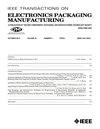Chemical and Mechanical Analysis of PCB Surface Treated by Argon Plasma to Enhance Interfacial Adhesion
IEEE Transactions on Electronics Packaging Manufacturing
Pub Date : 2009-09-15
DOI:10.1109/TEPM.2009.2029700
引用次数: 14
Abstract
Plasma treatment of printed circuit board (PCB) is a common step in the electronic packaging processes in order to modify the surface and enhance its adhesion to molding compound. In this paper, PCB surface modifications resulting from plasma treatment were investigated by chemical and mechanical analysis methods. The PCB substrate in consideration was for multichip package, consisting of a core layer sandwiched by solder resist (SR) material, which in turn was composed of epoxy, acryl resins, and several kinds of fillers. Argon was employed as a plasma gas and the number of times that the plasma treatment was applied was chosen as a variable to estimate the effect of repeated exposure to the SR surface during the manufacturing process. The resulting surface conditions were analyzed using roughness measurement, water contact angle measurement, X-ray photoelectron spectroscopy (XPS), nano-indentation, and nano-scratch test method. Comprehensive analyses made it possible to understand the characteristics of the effect of plasma on the PCB surface, i.e., SR material. It was found that the surface roughness after the one-time plasma treatment increased from ~ 62 to ~ 90nm, then decreased more or less to the initial level after three and eight times of repeated treatments. These roughness trends were explained by cleaning out contaminants accumulated in the surface crevices and then preferentially removing or melting away a thin resin layer from the peaks on the surface. The plasma treatment decreased the contact angle significantly and increased work of adhesion. Chemical analysis of these surfaces by XPS showed that the C-C bonds in SR were broken, the population of the polar groups such as O-H, C=O, and COOH increased, and the oxygen content increased. The polar groups increased surface energy, and resulted in increased PCB adhesion with the epoxy molding compound (EMC). Mechanical analysis by nano-indentation and nano-scratch test showed that the surface became soft and weak if plasma treatment was too excessive. In this case, a plasma affected zone corresponding to the severe C-C bond breakage was formed near the surface and the adhesion with EMC suffered. Therefore, caution should be exercised in determining the degree of plasma treatment needed.氩等离子体处理PCB表面增强界面附着力的化学和力学分析
等离子体处理印刷电路板(PCB)是电子封装过程中常见的步骤,以修饰其表面并增强其与成型化合物的附着力。本文采用化学和力学分析方法研究了等离子体处理对PCB表面的影响。所考虑的PCB基板是用于多芯片封装的,由芯层夹有阻焊剂(SR)材料组成,而阻焊剂又由环氧树脂、丙烯酸树脂和几种填料组成。采用氩气作为等离子体气体,选择等离子体处理的次数作为变量,以估计在制造过程中反复暴露于SR表面的影响。采用粗糙度测量、水接触角测量、x射线光电子能谱(XPS)、纳米压痕和纳米划痕测试等方法对所得表面状况进行分析。综合分析可以了解等离子体对PCB表面(即SR材料)的影响特性。结果表明,一次性等离子体处理后的表面粗糙度从~ 62 nm增加到~ 90nm,经过3次和8次重复处理后,表面粗糙度或多或少地下降到初始水平。这些粗糙度趋势可以通过清除积聚在表面裂缝中的污染物,然后优先去除或融化表面峰上的薄树脂层来解释。等离子体处理显著降低了接触角,增加了粘附功。XPS化学分析表明,SR中C-C键断裂,O- h、C=O、COOH等极性基团数量增加,氧含量增加。极性基团增加了表面能,并导致PCB与环氧成型化合物(EMC)的附着力增加。纳米压痕和纳米划痕的力学分析表明,等离子体处理过多会使表面变软变弱。在这种情况下,在表面附近形成了一个与严重的C-C键断裂相对应的等离子体影响区,与EMC的粘附受到影响。因此,在确定所需的血浆治疗程度时应谨慎行事。
本文章由计算机程序翻译,如有差异,请以英文原文为准。
求助全文
约1分钟内获得全文
求助全文

 求助内容:
求助内容: 应助结果提醒方式:
应助结果提醒方式:


